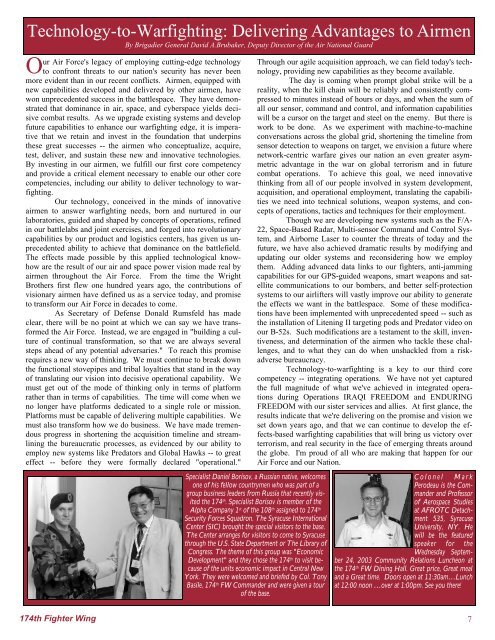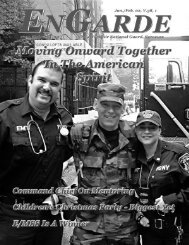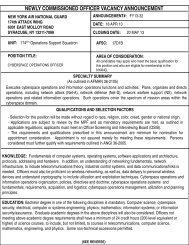Downloadable - Hancock Field Air National Guard Base
Downloadable - Hancock Field Air National Guard Base
Downloadable - Hancock Field Air National Guard Base
You also want an ePaper? Increase the reach of your titles
YUMPU automatically turns print PDFs into web optimized ePapers that Google loves.
Technology-to-Warfighting: Delivering Advantages to <strong>Air</strong>menBy Brigadier General David A.Brubaker, Deputy Director of the <strong>Air</strong> <strong>National</strong> <strong>Guard</strong>ur <strong>Air</strong> Force's legacy of employing cutting-edge technologyO to confront threats to our nation's security has never beenmore evident than in our recent conflicts. <strong>Air</strong>men, equipped withnew capabilities developed and delivered by other airmen, havewon unprecedented success in the battlespace. They have demonstratedthat dominance in air, space, and cyberspace yields decisivecombat results. As we upgrade existing systems and developfuture capabilities to enhance our warfighting edge, it is imperativethat we retain and invest in the foundation that underpinsthese great successes -- the airmen who conceptualize, acquire,test, deliver, and sustain these new and innovative technologies.By investing in our airmen, we fulfill our first core competencyand provide a critical element necessary to enable our other corecompetencies, including our ability to deliver technology to warfighting.Our technology, conceived in the minds of innovativeairmen to answer warfighting needs, born and nurtured in ourlaboratories, guided and shaped by concepts of operations, refinedin our battlelabs and joint exercises, and forged into revolutionarycapabilities by our product and logistics centers, has given us unprecedentedability to achieve that dominance on the battlefield.The effects made possible by this applied technological knowhoware the result of our air and space power vision made real byairmen throughout the <strong>Air</strong> Force. From the time the WrightBrothers first flew one hundred years ago, the contributions ofvisionary airmen have defined us as a service today, and promiseto transform our <strong>Air</strong> Force in decades to come.As Secretary of Defense Donald Rumsfeld has madeclear, there will be no point at which we can say we have transformedthe <strong>Air</strong> Force. Instead, we are engaged in "building a cultureof continual transformation, so that we are always severalsteps ahead of any potential adversaries." To reach this promiserequires a new way of thinking. We must continue to break downthe functional stovepipes and tribal loyalties that stand in the wayof translating our vision into decisive operational capability. Wemust get out of the mode of thinking only in terms of platformrather than in terms of capabilities. The time will come when weno longer have platforms dedicated to a single role or mission.Platforms must be capable of delivering multiple capabilities. Wemust also transform how we do business. We have made tremendousprogress in shortening the acquisition timeline and streamliningthe bureaucratic processes, as evidenced by our ability toemploy new systems like Predators and Global Hawks -- to greateffect -- before they were formally declared "operational."Through our agile acquisition approach, we can field today's technology,providing new capabilities as they become available.The day is coming when prompt global strike will be areality, when the kill chain will be reliably and consistently compressedto minutes instead of hours or days, and when the sum ofall our sensor, command and control, and information capabilitieswill be a cursor on the target and steel on the enemy. But there iswork to be done. As we experiment with machine-to-machineconversations across the global grid, shortening the timeline fromsensor detection to weapons on target, we envision a future wherenetwork-centric warfare gives our nation an even greater asymmetricadvantage in the war on global terrorism and in futurecombat operations. To achieve this goal, we need innovativethinking from all of our people involved in system development,acquisition, and operational employment, translating the capabilitieswe need into technical solutions, weapon systems, and conceptsof operations, tactics and techniques for their employment.Though we are developing new systems such as the F/A-22, Space-<strong>Base</strong>d Radar, Multi-sensor Command and Control System,and <strong>Air</strong>borne Laser to counter the threats of today and thefuture, we have also achieved dramatic results by modifying andupdating our older systems and reconsidering how we employthem. Adding advanced data links to our fighters, anti-jammingcapabilities for our GPS-guided weapons, smart weapons and satellitecommunications to our bombers, and better self-protectionsystems to our airlifters will vastly improve our ability to generatethe effects we want in the battlespace. Some of these modificationshave been implemented with unprecedented speed -- such asthe installation of Litening II targeting pods and Predator video onour B-52s. Such modifications are a testament to the skill, inventiveness,and determination of the airmen who tackle these challenges,and to what they can do when unshackled from a riskadversebureaucracy.Technology-to-warfighting is a key to our third corecompetency -- integrating operations. We have not yet capturedthe full magnitude of what we've achieved in integrated operationsduring Operations IRAQI FREEDOM and ENDURINGFREEDOM with our sister services and allies. At first glance, theresults indicate that we're delivering on the promise and vision weset down years ago, and that we can continue to develop the effects-basedwarfighting capabilities that will bring us victory overterrorism, and real security in the face of emerging threats aroundthe globe. I'm proud of all who are making that happen for our<strong>Air</strong> Force and our Nation.Specialist Daniel Borisov, a Russian native, welcomesone of his fellow countrymen who was part of agroup business leaders from Russia that recently visitedthe 174 th . Specialist Borisov is member of theAlpha Company 1 st of the 108 th assigned to 174 thSecurity Forces Squadron. The Syracuse InternationalCenter (SIC) brought the special visitors to the base.The Center arranges for visitors to come to Syracusethrough the U.S. State Department or The Library ofCongress. The theme of this group was "EconomicDevelopment" and they chose the 174 th to visit becauseof the units economic impact in Central NewYork. They were welcomed and briefed by Col. TonyBasile, 174 th FW Commander and were given a tourof the base.C olonel MarkPerodeau is the Commanderand Professorof Aerospace Studiesat AFROTC Detachment535, SyracuseUniversity, NY. Hewill be the featuredspeaker for theWednesday September24, 2003 Community Relations Luncheon atthe 174 th FW Dining Hall. Great price, Great mealand a Great time. Doors open at 11:30am…Lunchat 12:00 noon …over at 1:00pm. See you there!174th Fighter Wing7
















